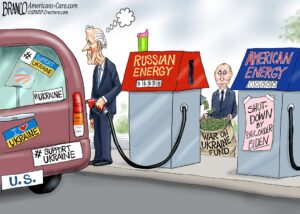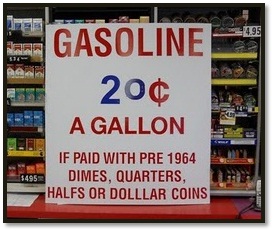
In 1997, Former Federal Reserve Chairman Ben Bernanke, while still an academic, wrote a famous historical study for the Brookings Institution: “Systematic Monetary Policy and the Effects of Oil Price Shocks” with Mark Gertler and Mark Watson.
It began by documenting that “essentially all the U.S. recessions of the past thirty years have been preceded by both oil price increases and a tightening of monetary policy.” So here we are again tightening monetary policy at a time of unaffordable oil price increases.
In fact, Fed Chairman Jerome Powell argues the Fed must be more aggressive about raising the federal funds rate higher and faster precisely because Russia’s war on Ukraine has inflated global prices of oil, natural gas, grains and more.
At a March talk to the National Association of Business Economists Chairman Powell lamented, “The added near‐term upward pressure from the invasion of Ukraine on inflation from energy, food, and other commodities comes at a time of already too high inflation. In normal times … monetary policy would look through a brief burst of inflation associated with commodity price shocks. However, the risk is rising that an extended period of high inflation could push longer‐term expectations uncomfortably higher.”
That is a relatively hazy anxiety, since expectations change when the facts change. The University of Michigan survey of inflation expected over the next 12 month moves up down with monthly changes in reported actual inflation over the past 12 months (the infamous year‐to‐year change). That survey of expected inflation even moves up and down with contemporary changes in the price of gasoline.
What we know we almost perfect certainty is that every time in U.S. postwar history that monetary policy has added the burden of rising interest expense to the burden of added energy expense (most recently in 2004–2008), the result has always been recession.
But some will say that recession (always promised to be mild) is the price we must pay to get inflation down, which it does briefly while the recession is underway. But recessions always result in the Fed reversing course and slashing the fed funds rates – from 17.6% to 9% from April to July 1980 under Volcker, and from 5 ¼ % to zero in 2007-08 under Bernanke.
The difference between 9 hard landings and 4 soft landings in Fed interest rate cycles is that the Fed always starts cutting interest rates before recessions start in soft landings, and always starts too late in hard landings.

This work is licensed under a Creative Commons Attribution-NonCommercial-ShareAlike 4.0 International License. Original here.
